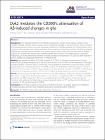| dc.contributor.author | LYNCH, MARINA | en |
| dc.contributor.author | MURPHY, NIAMH | en |
| dc.contributor.author | COSTELLO, DEREK | en |
| dc.contributor.author | DOWNER, ERIC | en |
| dc.date.accessioned | 2013-08-07T13:32:49Z | |
| dc.date.available | 2013-08-07T13:32:49Z | |
| dc.date.issued | 2012 | en |
| dc.date.submitted | 2012 | en |
| dc.identifier.citation | Lyons A, Downer EJ, Costello DA, Murphy N, Lynch MA, Dok2 mediates the CD200Fc attenuation of Aß-induced changes in glia., Journal of neuroinflammation, 9, 2012, 107 | en |
| dc.identifier.other | Y | en |
| dc.identifier.uri | http://hdl.handle.net/2262/66892 | |
| dc.description | PUBLISHED | en |
| dc.description.abstract | Background:
The interaction between the membrane glycoprotein, CD200 and its cognate receptor CD200
receptor (CD200R), has been shown to play a role in maintaining microglia in a quiescent state. There is evidence
of increased activation under resting and stimulated conditions in microglia prepared from CD200-deficient mice
compared with wild-type mice, whereas activation of the receptor by CD200 fusion protein (CD200Fc) ameliorates
inflammatory changes which are evident in the central nervous system (CNS) of the mouse model of multiple
sclerosis (MS), experimental autoimmune encephalomyelitis (EAE) and also in the hippocampus of aged rats.
Additionally, an inverse relationship between microglial activation and expression of CD200 has been observed in
animals treated with lipopolysaccharide (LPS) or amyloid-
?
(A
?
).
Methods:
We assessed the effect of CD200R activation by CD200Fc on A
?
-induced production of the pro-
inflammatory cytokines, interleukin-1
?
(IL-1
?
) and tumor necrosis factor-
?
(TNF
?
) and the expression of microglial
activation markers, CD68 and CD40 in cultured glia. The role played by downstream of tyrosine kinase 2 (Dok2)
phosphorylation in mediating the effects of CD200R activation was evaluated by siRNA knockdown of Dok2. To
further examine the impact of inflammatory changes on synaptic plasticity, the effect of CD200Fc on A
?
-induced
impairment of long-term potentiation (LTP) in the CA1 region of hippocampal slices was also investigated.
Results:
We demonstrate that A
?
-induced increases in IL-1
?
, TNF
?
, CD68 and CD40 were inhibited by CD200Fc.
The evidence suggests that Dok2 phosphorylation is a key factor in mediating the effect of CD200Fc, since Dok2
knockdown by siRNA abrogated its effects on microglial activation and inflammatory cytokine production.
Consistent with evidence that inflammatory changes negatively impact on LTP, we show that the A
?
-induced
impairment of LTP was attenuated by CD200Fc.
Conclusions:
The findings suggest that activation of CD200R and Dok2 is a valuable strategy for modulating
microglial activation and may have therapeutic potential in neurodegenerative conditions. | en |
| dc.description.sponsorship | This work was supported by Science Foundation Ireland, The Health
Research Board and The Higher Education Authority, Ireland (PTRLI) | en |
| dc.format.extent | 107 | en |
| dc.language.iso | en | en |
| dc.relation.ispartofseries | Journal of neuroinflammation | en |
| dc.relation.ispartofseries | 9 | en |
| dc.rights | Y | en |
| dc.subject | A ? , CD200, Cytokines, Microglia, siRNA, Dok2, Phagocytosis | en |
| dc.subject.lcsh | A ? , CD200, Cytokines, Microglia, siRNA, Dok2, Phagocytosis | en |
| dc.title | Dok2 mediates the CD200Fc attenuation of Aß-induced changes in glia. | en |
| dc.type | Journal Article | en |
| dc.type.supercollection | scholarly_publications | en |
| dc.type.supercollection | refereed_publications | en |
| dc.identifier.peoplefinderurl | http://people.tcd.ie/lynchma | en |
| dc.identifier.peoplefinderurl | http://people.tcd.ie/edowner | en |
| dc.identifier.rssinternalid | 83603 | en |
| dc.identifier.doi | http://dx.doi.org/10.1186/1742-2094-9-107 | en |




